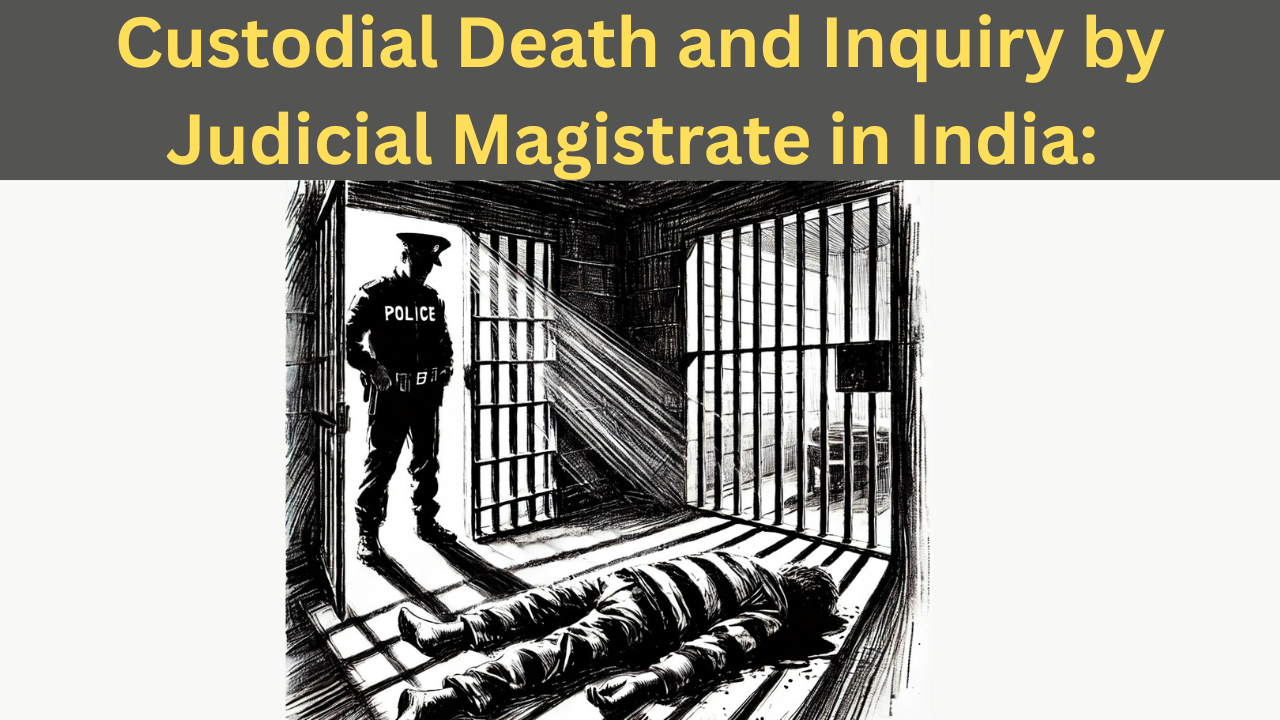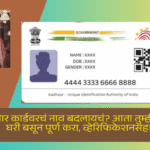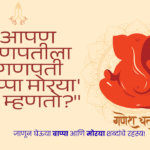Custodial Death and Inquiry by Judicial Magistrate in India:
Introduction:
Defining Custodial Death and its Constitutional and Societal Implications in India.
The term “custody” within the Indian legal system refers to the state of being under the protective care or guardianship of law enforcement officials or judicial authorities. This encompasses two primary forms: police custody, where an accused person is physically detained by the police, typically for the purpose of investigation following an arrest 1; and judicial custody, where the accused is detained under the order of a magistrate, usually in a jail or designated facility supervised by the judiciary 1.
It is important to note that while every arrest invariably leads to custody, not every instance of custody is consequent to an arrest 3. The distinction is crucial, particularly concerning the rights of the detained individual and the powers of the detaining authorities, as police interrogation is generally not permitted during judicial custody unless specifically ordered by the magistrate 3.
Custodial death is defined as the demise of a person while in the custody of either the police or the judiciary, and this death is either directly or indirectly related to, or significantly attributable to, activities that occurred during the period of custody 1. This definition extends beyond deaths occurring within the confines of a police station or jail to include fatalities that may take place in police vehicles, medical facilities, or even public spaces, provided the individual was under the control or authority of the police or judicial system at the time 3. The causes of custodial death can be varied, ranging from alleged torture or violence inflicted by custodial authorities to negligence in providing medical care, or even natural causes that occur while an individual is in custody 3.
The occurrence of custodial deaths carries profound constitutional implications in India, primarily as a grave violation of Article 21 of the Constitution, which guarantees the right to life and personal liberty to every citizen 1. This fundamental right is interpreted to include not just the right to survive, but the right to live with dignity and freedom from torture or inhuman treatment 1. The very act of custodial death, particularly when resulting from torture or negligence, is considered an affront to human dignity and a direct contravention of this constitutional guarantee 1.
Furthermore, Articles 20 and 22 of the Constitution also provide safeguards to arrested and detained persons, and custodial deaths often represent a violation of these rights as well 3. Beyond the constitutional ramifications, custodial deaths have significant societal implications. They erode public trust in law enforcement agencies and the broader justice system, raising serious questions about the state’s ability to protect the lives and liberties of individuals, especially those within its custody 2. The perception that individuals may forfeit their fundamental right to life upon being arrested is antithetical to the principles of a civilized society governed by the rule of law 1. The increasing number of custodial deaths over the years has become a matter of grave concern, highlighting the urgent need to understand and address the underlying causes and procedural inadequacies in the system 1.
The Legal Framework Governing Custodial Deaths:
Custodial death in India refers to the death of individuals while in the custody of the police or in judicial custody during trial or while serving a sentence 3. Statistics from the National Human Rights Commission of India indicate the concerning prevalence of such incidents, with 2152 deaths reported in judicial custody and 155 in police custody in the financial year 2021-22 alone 4.
The Indian Constitution provides several fundamental rights that serve as crucial safeguards against custodial violence and death. Article 20 offers protection against arbitrary and excessive punishment to an accused person, encompassing the prohibition of ex-post-facto laws, double jeopardy (Article 20(2)), and self-incrimination (Article 20(3)) 3. Article 21, the cornerstone of the right to life and personal liberty, is interpreted to include the right to live with human dignity and protection against torture and assault, even by the state and its functionaries 1. This right cannot be suspended even upon arrest 1. Article 22 further guarantees protection against arbitrary arrest and detention, ensuring the right to be informed of the grounds of arrest, to consult a lawyer of one’s choice, and to be produced before the nearest magistrate within 24 hours of arrest 3.
Beyond these constitutional safeguards, several statutory provisions within the Code of Criminal Procedure (CrPC) and the Indian Penal Code (IPC) address custodial deaths and related issues. The CrPC contains specific provisions aimed at protecting individuals in custody. Section 46 explicitly states that the police cannot cause the death of a person who is not accused of an offense punishable with death or imprisonment for life while making an arrest 4. Section 49 prohibits the use of more restraint than is necessary to prevent the escape of the person arrested 3.
Section 54 allows a magistrate to direct the medical examination of an arrested person if they allege ill-treatment 3. Section 57 mandates that a person arrested without a warrant cannot be detained in custody by the police for more than 24 hours without a special order from a magistrate, as per Section 167, which outlines the permissible periods for detention in police and judicial custody 3. Crucially, Section 176 of the CrPC empowers a Judicial Magistrate to order an inquiry into the cause of death when a person dies or disappears in custody, or if a woman is raped while in custody 3. A significant amendment in 2005 made a judicial inquiry mandatory in cases of death, disappearance, or rape occurring in police custody or any other custody authorized by a magistrate or the court 16.
The Indian Penal Code also includes provisions to address offenses related to custodial deaths. Section 302 prescribes punishment for murder, which would apply if a police officer is found to have murdered an individual in custody 3. Section 304 deals with culpable homicide not amounting to murder and causing death by negligence, which can be invoked in cases of custodial deaths resulting from such acts 3. Section 306 addresses the abetment of suicide, which could be relevant if a person in custody dies by suicide due to police actions 3. Sections 330 and 331 provide for the punishment of police officers who voluntarily cause hurt or grievous hurt, respectively, to extort a confession or information 3. Additionally, Section 342 punishes wrongful confinement 3.
The National Human Rights Commission (NHRC) has also played a crucial role in establishing guidelines to be followed in cases of custodial deaths. These guidelines mandate the reporting of all custodial deaths and rapes to the NHRC by the District Magistrates and Superintendents of Police within 24 hours of their occurrence 3. Failure to report promptly can lead to the presumption of an attempted cover-up 8. The NHRC also requires the video filming of all post-mortem examinations conducted in cases of deaths in police custody and in jails 8. Furthermore, the Commission has recommended the adoption of a Model Autopsy Form and adherence to additional procedures for inquests to ensure thorough and transparent investigations 12. Over the years, the NHRC has issued and revised various guidelines concerning arrest procedures, including the preparation of an arrest memo, informing relatives of the arrest, and conducting medical examinations of the arrested person 3.
Landmark judgments by the Supreme Court have significantly shaped the legal landscape concerning custodial deaths. The case of D.K. Basu vs. State of West Bengal (1996) is particularly noteworthy. In this case, the Supreme Court laid down a comprehensive set of 11 guidelines that must be followed during arrest and detention to prevent custodial violence 2. These guidelines include requirements for police personnel to wear identification tags, for the preparation of an arrest memo attested by a witness, for informing a friend or relative of the arrest, and for providing the arrested person with a medical examination 5.
Violation of these guidelines can attract not only departmental action but also contempt of court proceedings 30. Another significant judgment is Nilabati Behera vs. State of Orissa (1993), where the Supreme Court held that the state is obligated to provide compensation to the victim or their family for violating the constitutional right to life in cases of custodial death 3. The Arnesh Kumar case further issued guidelines to prevent unnecessary arrests by the police 18. The Supreme Court has consistently reiterated the principle that prisoners and detainees do not cease to have fundamental rights under Article 21, and only restrictions permitted by law can be imposed on their enjoyment of these rights 30.
Efforts towards reforming the legal framework continue. The 2008 amendment to the CrPC incorporated some of the suggestions made in the D.K. Basu verdict 4. The Law Commission of India has recommended that India ratify the United Nations Convention Against Torture and enact a specific law to criminalize torture by government agents 4. The Prevention of Custodial Torture Bill, 2023, was introduced in the Rajya Sabha, aiming to provide a framework for preventing custodial torture, punishing perpetrators, and providing compensation and rehabilitation to victims 26. A similar bill, the Prevention of Torture Bill, 2010, was passed by the Lok Sabha but subsequently lapsed in the Rajya Sabha 26.
Despite this comprehensive legal framework, the persistent occurrence of custodial deaths in India indicates significant challenges in the effective implementation and enforcement of these provisions. The gap between the legal ideals and the reality on the ground underscores the need for continued vigilance and reform.
| Act/Document | Relevant Article/Section/Guideline | Brief Description |
| Constitution of India | Article 21 | Guarantees the right to life and personal liberty, including dignity and freedom from torture. |
| Code of Criminal Procedure (CrPC) | Section 176 | Empowers Judicial Magistrate to inquire into custodial deaths; made mandatory in specific cases by 2005 amendment. |
| Indian Penal Code (IPC) | Section 302 | Prescribes punishment for murder, applicable to custodial killings by police officers. |
| NHRC Guidelines | Reporting within 24 hours | Mandates District Magistrates and Superintendents of Police to report custodial deaths to NHRC within 24 hours. |
| D.K. Basu Judgment (1996) | 11 Guidelines | Lays down specific procedures to be followed during arrest and detention to prevent custodial violence. |
| Nilabati Behera Judgment (1993) | Obligation to provide compensation | Holds the state responsible for providing compensation for violations of the right to life in custodial death cases. |
Mandatory Procedures and Protocols Following a Custodial Death in India.
Upon the occurrence of a custodial death in India, a stringent set of mandatory procedures and protocols are immediately activated to ensure transparency and accountability. The first crucial step is the immediate reporting of the incident to the National Human Rights Commission (NHRC). District Magistrates and Superintendents of Police across the country are obligated to report such deaths, whether in police or judicial custody, to the Secretary General of the NHRC within 24 hours of the occurrence or upon them becoming aware of it 3. This directive was initially issued by the NHRC in 1993 5. Failure to adhere to this reporting requirement can lead to the presumption of an attempted cover-up of the incident 8.
Following the reporting, a mandatory judicial inquiry must be conducted by a Judicial Magistrate or a Metropolitan Magistrate under Section 176(1A) of the Code of Criminal Procedure (CrPC) in all cases of death, disappearance, or rape that occur while a person is in police custody or any other custody authorized by a magistrate or the court 4. This inquiry is in addition to any investigation or inquiry that may be conducted by the police 15. Notably, this mandatory inquiry cannot be conducted by an Executive Magistrate; it must be carried out by a Judicial Magistrate 16. The provision emphasizes that this requirement applies to all such cases, irrespective of whether there is an initial suspicion of foul play 17.
Within 24 hours of the death, the Magistrate holding the inquiry is mandated under Section 176(5) of the CrPC to forward the body to the nearest Civil Surgeon for a post-mortem examination 15. Furthermore, in line with the NHRC guidelines, the post-mortem examination in all cases of custodial deaths, whether in police custody or in jails, should be video-filmed 8. The cassettes of these recordings are required to be sent to the NHRC along with the post-mortem report 8.
Inquest proceedings are also a crucial part of the mandatory procedures following a custodial death, often involving the preparation of an “inquest Panchama,” which is a record of the scene and initial findings made in the presence of independent witnesses 35. Additionally, Section 176 of the CrPC stipulates that the Magistrate conducting the inquiry should, wherever practicable, inform the relatives of the deceased whose names and addresses are known and allow them to be present during the inquiry 15. The guidelines laid down in the D.K. Basu case also mandate a proper medical examination of the deceased at the time of arrest and during custody, including the documentation of any injuries present on the body 5.
While these mandatory procedures underscore the importance of transparency and independent oversight through judicial involvement and thorough documentation, reports indicate a concerning lack of consistent compliance, particularly with the requirement for a judicial inquiry under Section 176(1A) of the CrPC 16. This suggests a significant gap between the legally mandated procedures and their actual implementation on the ground.

The Role and Powers of a Judicial Magistrate in Inquiry:
The role of a Judicial Magistrate in conducting an inquiry into a custodial death is established under Section 176 of the Code of Criminal Procedure (CrPC). This section empowers the Judicial Magistrate to hold an inquiry when a person dies or disappears while in custody, or in cases where a woman is raped in custody 3. The Magistrate can order such an inquiry either in addition to or instead of an investigation conducted by the police 16. As highlighted earlier, an amendment to Section 176 made it mandatory for a Judicial Magistrate or a Metropolitan Magistrate to hold an inquiry in cases of death, disappearance, or rape in police or other authorized custody 16.
The scope of the Judicial Magistrate’s inquiry is comprehensive. It aims to delve into the cause of death and the sequence of events leading to it 16. The inquiry seeks to determine whether any individual was responsible for the death or if any foul play was involved 16. Furthermore, it examines any acts of commission or omission on the part of public servants that may have contributed to the death 16. The adequacy of the medical treatment provided to the deceased is also a crucial aspect of the inquiry 16. The ultimate goal is to ascertain the circumstances of the death, prevent similar incidents in the future, and inform the next of kin while reassuring the public about the authorities’ commitment to upholding national and international standards 43. These investigations are considered criminal in nature, focused on determining whether any criminal laws were violated that resulted in the death 46.
The expected outcomes of a Judicial Magistrate’s inquiry include the submission of a detailed inquiry report to the relevant authorities 42. This report should clearly identify the cause of death 16 and pinpoint responsibility if any is found 16. Based on the findings, the Magistrate may recommend specific actions against the individuals held responsible 23. If the inquiry reveals the commission of a cognizable offense, it can lead to the registration of a First Information Report (FIR) 12.
The outcome of the inquiry can also significantly influence decisions regarding the compensation to be provided to the family of the deceased 3. The inquiry’s purpose is to find any person responsible for the death, identify any acts of commission or omission by public servants that contributed to it, and assess the appropriateness of the medical treatment provided 16. Previous instances show that magisterial inquiries have led to the registration of criminal cases, departmental action against police officers, and the provision of ex-gratia compensation to the deceased’s family 23.
The involvement of a Judicial Magistrate provides an essential layer of independent oversight in cases of custodial deaths, acting as a crucial safeguard against potential bias in investigations conducted solely by the police. The mandatory nature of this inquiry in specific custodial death scenarios underscores its significance in upholding the principles of justice and accountability. The potential for the inquiry to lead to tangible outcomes, such as the prosecution of responsible individuals and the provision of remedies to the victims’ families, highlights its importance in ensuring a fair and just criminal justice system.
The Process of a Judicial Magistrate’s Inquiry:
The process of a Judicial Magistrate’s inquiry into a custodial death typically commences upon the Magistrate receiving information about such an incident 3. This information often originates from reports filed by the police or other sources, including directives from the NHRC 3. The inquiry should ideally be initiated at the earliest possible time, without any undue delay 42.
A crucial aspect of the inquiry involves the gathering of evidence and the examination of relevant records. The Magistrate may visit the place where the custodial death occurred to gain a firsthand understanding of the facts and circumstances 42. A thorough examination of various documents is undertaken, including the inquest report prepared by the police, the post-mortem examination report, viscera analysis reports (if conducted), records of medical treatment provided to the deceased, inquiry or investigation reports prepared by the police, the First Information Report (FIR), entries in the General Diary (GD), ballistic examination reports of any weapons or cartridges involved, and forensic examination reports 42. The Magistrate is expected to critically analyze the post-mortem report to assess the genuineness of any claims or allegations related to the death 42. The process also involves ensuring that all relevant evidence is collected and secured appropriately 43.
Recording the testimonies of witnesses is another vital component of the judicial inquiry. The Magistrate examines various individuals who may have information relevant to the case, including family members and relatives of the deceased, eyewitnesses to the events leading to the death, doctors who conducted the post-mortem or provided treatment, concerned police or prison officials, independent witnesses, and co-prisoners who may have been in custody with the deceased 42. To ensure that all potential witnesses are aware of the inquiry, public notices may be issued through vernacular newspapers 42.
The Magistrate must ensure that the relatives of the victim are given a free and fair opportunity to record their statements 42. The Magistrate also possesses the power to administer oaths to the witnesses during the recording of their evidence 39. Given the frequent lack of direct eyewitness evidence in cases of custodial death, relying on the explanations provided by police officials and the testimonies of other witnesses becomes particularly important 16.
Upon completion of the evidence gathering and examination, the Magistrate is required to submit a detailed inquiry report. This report should contain a summary of the statements recorded, the documents examined, a discussion of the allegations and whether they were proven, and the reasoning behind the conclusions reached 42. The report must also include a specific and definite opinion on the circumstances that led to the death, whether the use of force (if any) was justified, and whether the actions taken were lawful 42.
Furthermore, the Magistrate may suggest any systemic changes or improvements that could be implemented to prevent similar incidents from occurring in the future 42. If any acts of commission or omission by public servants are found to have contributed to the death, these should be specified in the report, along with the names of the officials responsible 42. The National Human Rights Commission has set a guideline of two months for the completion of such inquiries by the Magistrate 16.
The entire process of a Judicial Magistrate’s inquiry is designed to be thorough, impartial, and aimed at ensuring a comprehensive understanding of the circumstances surrounding a custodial death. The multiple stages of evidence collection, witness examination, and the preparation of a detailed report contribute to this objective. The emphasis on recording testimonies, especially from non-official sources, is crucial in providing a balanced and complete account of the events, thereby enhancing the integrity of the inquiry process.
Inquest Panchama: Meaning, Purpose, and Process:
Inquest Panchama, often referred to simply as “Panchnama” in the context of an inquest, is a significant procedural document prepared during the investigation of sudden, suspicious, or unnatural deaths under Section 174 of the Code of Criminal Procedure (CrPC) 36. The term “Panchnama” literally translates to a “record of observation by five people,” although in practice, it is prepared in the presence of two or more respectable inhabitants of the locality, who are known as “Panchas” 36.
The primary purpose of the Inquest Panchama in investigating unnatural deaths is to ascertain the apparent cause of death and the circumstances surrounding it 36. It serves to record a detailed description of the scene where the death occurred and any visible injuries present on the body of the deceased 35. The Panchnama provides preliminary information that forms the basis for further investigation into the cause and manner of death 38. Specifically, its aims include determining the identity of the deceased (if unknown), establishing how, when, and where the death occurred, and identifying the cause or circumstances that led to the death 45.
The process of conducting an Inquest Panchama involves the police officer in charge of the police station, or another police officer specifically empowered for this purpose, proceeding to the location where the dead body has been found 36. This investigation is carried out in the presence of two or more independent and respectable individuals from the local area, the “Panchas” 36. The police officer examines the body and the surrounding area, noting any relevant features such as the number, position, and direction of wounds, signs of struggle, and the presence of any biological materials 37. The witnesses, or Panchas, observe this process and the findings made by the police 52.
Following the examination, the inquest report, or Panchnama, is prepared on the spot. This report details the apparent cause of death, describes any injuries observed, and records other pertinent observations made at the scene 36. Once prepared, the report is signed by the police officer conducting the inquest and by the Panchas who were present as witnesses 35. The completed inquest report is then submitted to the District Magistrate or the Sub-Divisional Magistrate for their perusal 37.
The documentation required for an Inquest Panchama primarily includes the Panchnama report itself, which contains specific details about the deceased and the circumstances of death. This includes the apparent cause of death, a description of any wounds, fractures, bruises, or other visible signs of injury, an assessment of how these injuries might have been inflicted, and the identification of any potential weapons or instruments involved 38. The report also typically includes the deceased’s height, color, any distinguishing marks, the state of the body, and a list of any property found on it 61.
A detailed description of the exact location where the body was discovered is also recorded 61. While the Panchnama is the central document, other related documents in a broader investigation might include medical certificates, medico-legal reports, and dying declarations, if available 37.
In essence, the Inquest Panchama serves as a critical initial record in the investigation of unnatural deaths, providing a documented account of the death scene and preliminary findings by the police, attested to by independent local witnesses. While it is an important procedural step, it is generally considered corroborative evidence rather than substantive proof in court 52. An FIR, for instance, cannot be registered solely on the basis of a Panchnama 57.
Comparing and Contrasting the Roles and Responsibilities:
The Judicial Magistrate’s Inquiry and the Inquest Panchama are two distinct yet related processes involved in investigating custodial deaths in India. While both aim to shed light on the circumstances surrounding such deaths, they differ significantly in their authority, scope, mandatory nature, evidentiary value, and the involvement of various parties.
The primary distinction lies in the authority conducting the investigation. The Judicial Magistrate’s inquiry is conducted by a judicial officer vested with magisterial powers under Section 176 of the CrPC, signifying an independent judicial oversight 36. In contrast, the Inquest Panchama is conducted by the police under Section 174 of the CrPC, representing the initial phase of the police investigation into an unnatural death 36. Reflecting this difference in authority, a Magistrate’s inquest is considered superior to a police inquest 36.
The scope of the Judicial Magistrate’s inquiry is considerably broader. It aims to comprehensively determine the cause of death, identify any individuals responsible, and explore potential systemic issues that might have contributed to the death 16. It involves a detailed examination of various witnesses, including family members, officials, and independent sources, and a thorough review of documentary evidence. Furthermore, it has been mandatory since the 2005 amendment in specific cases of death, disappearance, or rape in police or other authorized custody 16.
On the other hand, the Inquest Panchama has a more limited scope, primarily focused on recording the initial observations at the scene of death and documenting the apparent cause of unnatural deaths 37. While mandatory for all unnatural or suspicious deaths, its purpose is more preliminary, laying the groundwork for further investigation 36.
The evidentiary value of the outcomes from these two processes also differs. The report submitted by the Judicial Magistrate following their inquiry carries more weight and can directly influence subsequent legal proceedings, potentially leading to the registration of an FIR or informing decisions on compensation. The Panchnama prepared during the Inquest Panchama, while an essential record, primarily serves as corroborative evidence to support other findings and to demonstrate that the police followed the initial procedural requirements 52.
The involvement of parties also varies. A Judicial Magistrate’s inquiry can involve examining a wide array of witnesses and often allows for legal representation. In contrast, the Inquest Panchama primarily involves the police officer conducting the inquest and two independent local witnesses, the Panchas, who are present to attest to the findings 36.
Despite these differences, both processes share the overarching objective of investigating the circumstances surrounding a death in custody. Both involve recording observations at the scene and may include an examination of the deceased’s body. Both also require documentation of the findings in the form of an inquiry report or a Panchnama, and both are initiated upon receiving information about a death in custody.
In summary, while the Inquest Panchama is a crucial first step conducted by the police to record initial observations in cases of unnatural death, the Judicial Magistrate’s inquiry provides a more in-depth and legally significant investigation conducted by an independent judicial officer, especially in cases of custodial death where allegations of foul play or negligence may arise. The latter offers a higher degree of scrutiny and has a greater potential to lead to accountability and justice.
Custodial Death and Inquiry by Judicial Magistrate in India: proving-call-detail-records-cdr-in-indian-courts-a-comprehensive-analysis/
| Feature | Judicial Magistrate’s Inquiry | Inquest Panchama |
| Authority | Judicial Officer (Magistrate) under Section 176 CrPC | Police Officer under Section 174 CrPC |
| Scope | Broader; determines cause, responsibility, systemic issues; mandatory in specific custodial death cases. | Limited; records initial observations and apparent cause of unnatural deaths; preliminary to further investigation. |
| Mandatory Nature | Mandatory in cases of death, disappearance, or rape in police or other authorized custody (since 2005 amendment). | Mandatory for all unnatural or suspicious deaths. |
| Evidentiary Value | Higher; inquiry report can directly influence legal proceedings. | Lower; primarily corroborative evidence. |
| Involvement | Examines various witnesses, allows for legal representation. | Primarily involves the police officer and two independent local witnesses (Panchas). |
| Objective | To provide independent judicial oversight, ascertain cause and responsibility, recommend action. | To provide an initial documented account of the scene and preliminary findings. |
| Superiority | Considered superior to police inquest. | Considered inferior to Magistrate investigation. |
Recent Guidelines and Judgments Related to Custodial Deaths, Inquiry, and Inquest (2022-2024).
Recent years have seen continued attention from the judiciary and human rights bodies regarding the issue of custodial deaths, leading to specific guidelines and judgments aimed at strengthening the accountability mechanism.
In terms of recent guidelines, the National Human Rights Commission (NHRC) in June 2024 issued a notice to the Odisha government concerning a custodial death case, demanding an explanation for the non-payment of recommended compensation to the family of the deceased 19. This highlights the NHRC’s continued active role in monitoring and seeking redress for custodial deaths.
Earlier, in September 2020, the NHRC had reviewed its guidelines on judicial inquiry in custodial death and rape in light of the newly enacted Bharatiya Nyaya Sanhita, 2023 25. While no other specific new guidelines issued by the NHRC between 2022 and 2024 were prominently found in the provided snippets, the existing guidelines, particularly those emphasizing mandatory reporting, video filming of post-mortems, and adherence to the Model Autopsy Form, remain in effect 12.
Several recent judgments from the Supreme Court and High Courts reflect the judiciary’s approach to cases of custodial death. In Indira Vs. State Human Rights Commission (2024), the Supreme Court addressed allegations of custodial torture and the matter of compensation. While the court acknowledged that the deceased was “thrashed” in custody, it dismissed the direct compensation order due to an unclear cause of death, underscoring the need for conclusive evidence in such cases 9.
In a significant pronouncement in March 2024, the Supreme Court called for a stricter approach when granting bail to police officers accused in custodial death cases, referencing its earlier judgment in State of Jharkhand v Sandeep Kumar 33. This indicates the Supreme Court’s concern over the seriousness of custodial deaths and its inclination towards ensuring that accused police personnel are not easily released on bail.
High Courts have also been active in addressing custodial death cases. The Bombay High Court in November 2024 strongly criticized the Crime Investigation Department’s (CID) investigation into the custodial death of Akshay Shinde, the accused in the Badlapur sexual assault case. The court questioned the absence of crucial evidence and directed the CID to complete the magistrate’s inquiry within a strict deadline, emphasizing the need for a thorough and unbiased probe in custodial death cases 62.
Although slightly outside the 2022-2024 timeframe, the Madras High Court’s suo moto intervention in the P. Jeyaraj and Bennicks custodial deaths case in 2020 remains a significant precedent, where the court ordered a judicial inquiry and subsequently a CBI investigation due to public outrage over the alleged torture and deaths in police custody 16. More recently, in 2024, the Karnataka High Court in Dayananda and Anr. v. held that a First Information Report (FIR) cannot be registered solely based on a Panchnama, reinforcing the understanding of the Panchnama’s limited evidentiary value as primarily a record of initial observations 57.
Additionally, in October 2024, the High Court granted permission for a judicial review of an inquest into a death that occurred at a roadside while the individual was in police custody (R (Robinson) v HM Assistant Coroner), indicating the judiciary’s willingness to scrutinize the inquest process in cases of custodial death 64.
These recent guidelines and judgments collectively demonstrate a continued emphasis on ensuring accountability in cases of custodial death. The judiciary is actively overseeing investigations, emphasizing the need for thoroughness, impartiality, and adherence to legal procedures. The pronouncements also clarify the evidentiary standing of procedural documents like the Panchnama.
Conclusion and Recommendations: Strengthening Legal Safeguards and Ensuring Accountability in Cases of Custodial Death.
The analysis reveals a multi-layered legal framework in India designed to address the grave issue of custodial deaths. This framework encompasses constitutional rights, statutory provisions within the CrPC and IPC, guidelines issued by the NHRC and the Supreme Court, and ongoing legislative reforms.
Key judgments like D.K. Basu have established crucial procedural safeguards for arrests and detentions, while cases like Nilabati Behera have affirmed the state’s responsibility to compensate victims of custodial death. The mandatory judicial inquiry under Section 176(1A) CrPC represents a significant step towards ensuring independent oversight in such cases. The Inquest Panchama, conducted by the police, serves as an initial but important step in documenting unnatural deaths.
Despite these legal provisions, the persistent occurrence of custodial deaths indicates significant challenges in their effective implementation and enforcement 5. Issues such as non-compliance with mandatory guidelines, delays in the justice delivery system, and the potential for bias in investigations continue to be major concerns.
To strengthen the legal safeguards and ensure greater accountability in cases of custodial death, the following recommendations are proposed:
Enactment of a Specific Anti-Torture Legislation: India should urgently enact a standalone law that specifically criminalizes custodial violence and torture, aligning its domestic law with the United Nations Convention Against Torture, which India has signed but is yet to ratify 4.- Strict Compliance with Mandatory Judicial Inquiries: There needs to be a concerted effort to ensure strict compliance with the mandatory judicial inquiries under Section 176(1A) CrPC in all reported cases of custodial death, disappearance, or rape. This requires sensitization of the judiciary and law enforcement agencies, as well as effective monitoring mechanisms 16.
- Strengthening the Independence and Effectiveness of Inquiry Mechanisms: Measures should be taken to enhance the independence of the inquiry process, ensuring that Magistrates have the necessary resources and autonomy to conduct thorough investigations without any undue influence.
- Implementing Robust Witness Protection Programs: Effective witness protection programs are crucial to encourage victims and witnesses of custodial violence to come forward and provide testimony without fear of reprisal.
- Enhancing Training and Sensitization of Police Personnel: Comprehensive and regular training programs on human rights, lawful arrest and detention procedures, and the prohibition of torture should be mandatory for all police personnel 5.
- Promoting Transparency and Accountability: Increased transparency in police functioning, along with robust internal and external accountability mechanisms, is essential to deter custodial misconduct and ensure that perpetrators are brought to justice.
- Streamlining Compensation Processes: The process for awarding compensation to the families of victims of custodial death should be streamlined and expedited to provide timely relief.
- Implementing Prison Reforms: Addressing systemic issues within prisons, such as overcrowding, inadequate conditions, and staff shortages, is crucial to reducing the risk of deaths in judicial custody 5.
Ultimately, upholding the constitutional rights of every individual, including those in custody, is paramount for a just and humane criminal justice system. Continuous efforts are needed to bridge the gap between the existing legal framework and its effective implementation to prevent custodial deaths and ensure accountability for any violations.
Works cited
An era of guardians becoming perpetrators-custodial deaths: An analysis between the laws of India and UK, accessed on March 26, 2025, https://www.criminallawjournal.org/article/73/4-1-10-665.pdf- The role of the judiciary with relation to custodial death in India – IJAEM.net, accessed on March 26, 2025, https://ijaem.net/issue_dcp/The%20role%20of%20the%20judiciary%20with%20relation%20to%20custodial%20death%20in%20India.pdf
- Custodial Deaths In India: Status, Concerns, And Regulations …, accessed on March 26, 2025, https://pwonlyias.com/current-affairs/custodial-death-cases-in-india/
- Custodial deaths in India – Wikipedia, accessed on March 26, 2025, https://en.wikipedia.org/wiki/Custodial_deaths_in_India
- Examining Custodial Death: Challenges and Calls for Accountability – Drishti Judiciary, accessed on March 26, 2025, https://www.drishtijudiciary.com/blog/examining-custodial-death-challenges-and-calls-for-accountability
- A Study of Constitutional Protections Against Custodial Violence: A Critical Analysis – IJFMR, accessed on March 26, 2025, https://www.ijfmr.com/papers/2024/6/30405.pdf
- Custodial Death | 15 Feb 2023 – Drishti IAS, accessed on March 26, 2025, https://www.drishtiias.com/daily-updates/daily-news-analysis/custodial-death-1/print_manually
- Guidelines for Autopsy in Custodial Deaths – Cehat, accessed on March 26, 2025, https://www.cehat.org/uploads/files/Guidelines%20for%20autopsy%20in%20sustodial%20deaths%201.pdf
- Custodial Torture Led To Death – ALEC for Judiciary, accessed on March 26, 2025, https://www.alec.co.in/show-blog-page/custodial-torture-led-to-death
- custodial deaths – SVPNPA, accessed on March 26, 2025, https://www.svpnpa.gov.in/static/gallery/docs/14_custodiandeaths.pdf
- en.wikipedia.org, accessed on March 26, 2025, https://en.wikipedia.org/wiki/Custodial_deaths_in_India#:~:text=Section%20176%20(I)%20of%20the,anyone%20while%20performing%20an%20arrest.
- SELECTED NHRC GUIDELINES 1. On Custodial Deaths/Rapes a) Letter to all Chief Secretaries on the reporting of custodial deaths wi, accessed on March 26, 2025, https://www.mha.gov.in/sites/default/files/2022-12/NHRCselectedlettersandguidelinesondeathsincustody_09042019_0%5B1%5D.pdf
- Behind Bars: Addressing Custodial Deaths in India’s Criminal Justice System – IJFMR, accessed on March 26, 2025, https://www.ijfmr.com/papers/2024/2/14938.pdf
- Custodial Deaths – Answer, accessed on March 26, 2025, https://eparlib.nic.in/bitstream/123456789/616500/1/118090.pdf
- CrPC Section 176 – Inquiry by Magistrate into cause of death – Devgan.in, accessed on March 26, 2025, https://devgan.in/crpc/section/176/
- Custodial Deaths : What Is The Procedure For Inquiry?, Live Law, accessed on March 26, 2025, https://www.rightsrisks.org/in-media/custodial-deaths-what-is-the-procedure-for-inquiry-live-law/
- Interpretation of Section 176(1)(A) of Cr.PC – National Human Rights Commission India, accessed on March 26, 2025, https://nhrc.nic.in/sites/default/files/revised_order_intertretation_176_2020.pdf
- Custodial Torture in India: Intersection of Criminal Law and Constitutional Rights, accessed on March 26, 2025, https://www.scconline.com/blog/post/2024/03/23/custodial-torture-in-india-intersection-of-criminal-law-and-constitutional-rights/
- National Human Rights Commission (NHRC) issues notice to Odisha govt on custodial death row | Current Affairs | Vision IAS, accessed on March 26, 2025, https://visionias.in/current-affairs/news-today/2024-06-22/polity-and-governance/national-human-rights-commission-nhrc-issues-notice-to-odisha-govt-on-custodial-death-row
- Custodial Deaths – Answer, accessed on March 26, 2025, https://eparlib.nic.in/bitstream/123456789/650508/1/149695.pdf
- report of nhrc on custodial deaths – ANSWER, accessed on March 26, 2025, https://sansad.in/getFile/annex/217/Au2012.pdf?source=pqars
- Critical study on custodial violence and role of magistrate – iPleaders, accessed on March 26, 2025, https://blog.ipleaders.in/critical-study-on-custodial-violence-and-role-of-magistrate/
- Custodial Death – University of Minnesota Human Rights Library, accessed on March 26, 2025, http://hrlibrary.umn.edu/research/india-custodialdeaths.html
- Specific protocols for conducting medico-legal autopsies in cases of death in custody or following a violation of human rights: Indian perspective – IJHRMLP, accessed on March 26, 2025, https://ijhrmlp.org/article/specific-protocols-for-conducting-medico-legal-autopsies-in-cases-of-death-in-custody-or-following-a-violation-of-human-rights-indian-perspective
- SOP / Guidelines | National Human Rights Commission India, accessed on March 26, 2025, https://nhrc.nic.in/acts-&-rules/guidelines-1
- THE PREVENTION OF CUSTODIAL TORTURE BILL, 2023, accessed on March 26, 2025, https://sansad.in/getFile/BillsTexts/RSBillTexts/Asintroduced/custodial_torture-E1219202344710PM.pdf?source=legislation
- Human Rights & Custodial Deaths SUBJECT FORENSIC SCIENCE – e-PG Pathshala, accessed on March 26, 2025, https://epgp.inflibnet.ac.in/epgpdata/uploads/epgp_content/S000016FS/P000701/M015750/ET/1464334438FSC_P14_M33_e-text.pdf
- D.K. Basu Case Guidelines – Barnala Police, accessed on March 26, 2025, https://barnala.punjabpolice.gov.in/d-k-basu-case-guidelines/
- Supreme Court guidelines in DK Basu vs. State of West Bengal Arrest and Detention – Commonwealth Human Rights Initiative, accessed on March 26, 2025, https://www.humanrightsinitiative.org/download/1589358673DK%20Basu%20guidelines%20English.pdf
- DK BASU V. STATE OF WEST BENGAL – ALEC for Judiciary, accessed on March 26, 2025, https://www.alec.co.in/judgement-page/dk-basu-v-state-of-west-bengal
- Shri D.K. Basu,Ashok K. Johri vs State Of West Bengal,State Of U.P on 18 December, 1996, accessed on March 26, 2025, https://indiankanoon.org/doc/501198/
- DK Basu vs State of West Bengal – LawBhoomi, accessed on March 26, 2025, https://lawbhoomi.com/dk-basu-vs-state-of-west-bengal/
- Supreme Court (SC) calls for stricter approach in granting bail to police in custodial death cases | Current Affairs | Vision IAS, accessed on March 26, 2025, https://visionias.in/current-affairs/news-today/2024-03-29/polity-and-governance/supreme-court-sc-calls-for-stricter-approach-in-granting-bail-to-police-in-custodial-death-cases
- Case No -71/2008-09 – Maharashtra State Human Rights Commission, accessed on March 26, 2025, https://mshrc.gov.in/wp/wp-content/uploads/2024/08/Division-Bench-Case-No-71-2008-09.pdf
- www.jaypeedigital.com, accessed on March 26, 2025, https://www.jaypeedigital.com/eReader/chapter/9789350254936/ch1#:~:text=The%20Panchnama%20(inquest%20report)%20includes,of%20inquest%20report%20(Panchnama).
- PowerPoint Presentation, accessed on March 26, 2025, https://biu.edu.in/digital-content/660.pptx
- Forensic Medicine – JaypeeDigital | eBook Reader, accessed on March 26, 2025, https://www.jaypeedigital.com/eReader/chapter/9789350254936/ch1
- Inquest Report under CrPC – LawBhoomi, accessed on March 26, 2025, https://lawbhoomi.com/inquest-report-under-crpc/
- Inquest Principle – ROTI, accessed on March 26, 2025, https://rotiodisha.nic.in/files/TRAINING%20MATERIAL/PPT/Criminal/Inquest%20Principle.pptx
- The Code of Criminal Procedure, 1898 | 176. Inquiry by Magistrate into cause of death, accessed on March 26, 2025, http://bdlaws.minlaw.gov.bd/act-75/section-20872.html
- the code of criminal procedure, 1898 – PLJ Law Site, accessed on March 26, 2025, http://www.pljlawsite.com/html/Crpc176.htm
- Guidelines regarding conducting of Magisterial Enquiry in cases of Death in Custody or in the course of police action, accessed on March 26, 2025, https://nhrc.nic.in/sites/default/files/Guidelines_conducting_Magisterial_Enquiry_in_cases_of_CD_or_police_action.pdf
- Guidelines for investigating deaths in custody – ICRC, accessed on March 26, 2025, https://www.icrc.org/sites/default/files/external/doc/en/assets/files/publications/icrc-002-4126.pdf
- Department of Justice Guidance for State, Tribal, Local, and Territorial Law Enforcement Agencies on Best Practices for Conducti, accessed on March 26, 2025, https://www.justice.gov/d9/2023-05/Sec.%202%28a%29%20-%20DOJ%20Guidance%20for%20STLT%20LEAs%20on%20Investigations%20of%20In-Custody%20Deaths_FINAL.pdf
- Death in Custody – Inquest – Kevin Wu & Associates, accessed on March 26, 2025, https://www.kevinwuassociates.com/post/death-in-custody-inquest
- Georgia Bureau of Investigation Law Enforcement Use of Force and/or Custodial Death Investigations Manual, accessed on March 26, 2025, https://gbi.georgia.gov/document/document/use-force-custodial-death-inv-manual-revised-090415pdf/download
- rotiodisha.nic.in, accessed on March 26, 2025, https://rotiodisha.nic.in/files/TRAINING%20MATERIAL/PPT/Criminal/Inquest%20Principle.pptx#:~:text=Reporting%20such%20death%20to%20the,and%20its%20surrounding%20carefully%20%26%20closely.
- Section 174 CrPC – iPleaders, accessed on March 26, 2025, https://blog.ipleaders.in/section-174-croc/
- Ambit and Scope of Inquest Report under Section 174, Cr. P.C. – AIROnline, accessed on March 26, 2025, https://www.aironline.in/legal-articles/Ambit%20and%20Scope%20of%20Inquest%20Report%20under%20Section%20174,%20Cr.%20P.C.
- Inquest-Principles and Procedures | PDF | Coroner | Magistrate – Scribd, accessed on March 26, 2025, https://www.scribd.com/presentation/489517637/Inquest-Principle
- Ambit and Scope of Inquest Report under Section 174, Cr. P.C. – AIROnline, accessed on March 26, 2025, https://www.aironline.in/legal-articles/Ambit+and+Scope+of+Inquest+Report+under+Section+174%2C+Cr.+P.C.
- Panchanama – nacin, accessed on March 26, 2025, https://www.nacin.gov.in/ZCLucknow/Images/Documents/E_Books/57_Panchnama.pdf
- Deaths in Police Custody Inquest Solicitors – cj-law.co.uk, accessed on March 26, 2025, https://www.cj-law.co.uk/inquests/death-in-custody
- What happens at an Inquest? (And other frequently asked questions) – Healys LLP, accessed on March 26, 2025, https://healys.com/news-events-insights/what-happens-at-an-inquest
- Learn about the coroner’s inquest in Peach County, accessed on March 26, 2025, https://www.peachcounty.net/coroners-inquest.cfm
- CODE OF CRIMINAL PROCEDURE CHAPTER 49. INQUESTS UPON DEAD BODIES – Texas Statutes, accessed on March 26, 2025, https://statutes.capitol.texas.gov/docs/cr/htm/cr.49.htm
- Non-registration of FIR on the Basis of Panchnama – Drishti Judiciary, accessed on March 26, 2025, https://www.drishtijudiciary.com/current-affairs/non-registration-of-fir-on-the-basis-of-panchnama
- Supreme Court has clarified the legal status of ‘panchnamas’ UPSC – IAS Gyan, accessed on March 26, 2025, https://www.iasgyan.in/daily-current-affairs/panchnama
- What is Panchnama? – Vajiram & Ravi, accessed on March 26, 2025, https://vajiramandravi.com/upsc-daily-current-affairs/prelims-pointers/panchnama/
- Inquest – PANCHANAMA.pdf, accessed on March 26, 2025, https://www.slideshare.net/slideshow/inquest-panchanamapdf/256412795
- CHAPTER – XLI INVESTIGATION OF UNNATURAL DEATHS – Puducherry Police, accessed on March 26, 2025, https://police.py.gov.in/Police%20manual/Chapter%20PDF/CHAPTER%2041%20Investigation%20of%20Unnatural%20Deaths.pdf
- Bombay High Court criticises CID over custodial death probe in Badlapur case – India Today, accessed on March 26, 2025, https://www.indiatoday.in/india/law-news/story/bombay-high-court-criticises-cid-custodial-death-probe-akshay-shinde-badlapur-case-2635533-2024-11-19
- Custodial death of P Jayaraj and Bennicks – Wikipedia, accessed on March 26, 2025, https://en.wikipedia.org/wiki/Custodial_death_of_P_Jayaraj_and_Bennicks
- High Court grants permission to judicially review inquest into death at roadside in police custody – No5 Barristers’ Chambers, accessed on March 26, 2025, https://www.no5.com/2024/10/high-court-grants-permission-to-judicially-review-inquest-into-death-at-roadside-in-police-custody/
- India: Killings in Police Custody Go Unpunished – Human Rights Watch, accessed on March 26, 2025, https://www.hrw.org/news/2016/12/19/india-killings-police-custody-go-unpunished
![]()










